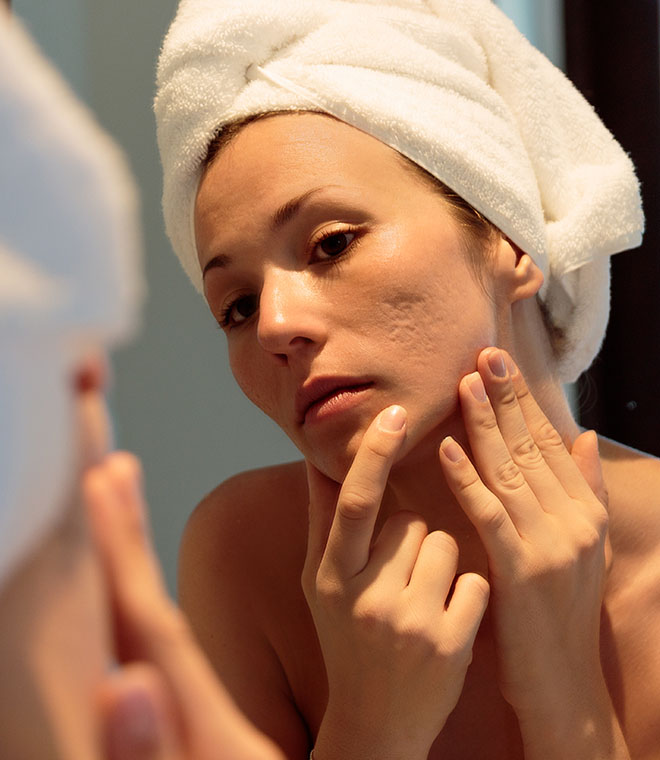Health
Chemical peel for acne scars
By Anna H. Chacon, MD, FAAD Dec 10, 2021 • 8 min
As frustrating as acne can be, the scars that are often left behind following breakouts can be even more challenging, especially because they typically last much longer than the breakout itself.
Chemical peels for the skin can improve the appearance of acne scars, allowing people to feel more confident about their skin.
What is a chemical peel?
A technique used to reduce the appearance of acne scars and improve the overall appearance of the skin, a chemical peel involves applying an exfoliating chemical solution to the skin, which causes the skin to peel off. When new skin grows back, it’s typically smoother, and scars are less noticeable. A chemical peel for acne scars isn’t generally covered by insurance, but it’s typically an affordable, effective treatment.
What does a chemical peel do?
Dermatologists use chemical peels to treat a range of skin conditions, including acne and acne scars. Chemical peels also reduce fine lines and wrinkles associated with aging, and they even out skin color, brighten the complexion and smooth the skin. Chemical peels also reduce the appearance of freckles, age spots, post-inflammatory hyperpigmentation (dark spots left behind after acne heals) and melasma, also referred to as “pregnancy mask,” when it occurs during pregnancy. Melasma is a common skin condition that causes brown or grayish-brown patches on areas of the skin that get a lot of sun.
Can anyone get a chemical peel?
Most people can undergo a chemical peel for acne scars. Your dermatologist will determine whether a peel is the right treatment for your scars or hyperpigmentation, and whether you meet the criteria for eligibility. You may need to avoid or delay a chemical peel if you:
- Currently have or recently had a bacterial, fungal or herpes infection
- Have had X-rays or radiation on your head or neck
- Have a suppressed immune system
- Had a major facial surgery within the past six months
- Have taken isotretinoin in the past 12 months
- Are pregnant
Chemical peel classifications
Chemical peels are classified based on how deeply the chemicals penetrate the skin.
- Superficial peels are used for mild skin disorders like acne, post-inflammatory hyperpigmentation and other conditions that cause discoloration. Superficial chemical peels penetrate the epidermis, or the topmost, protective layer of skin and the papillary dermis, the layer of skin just below the epidermis that supplies nutrients to the epidermis.
After a superficial peel, your skin will be red, and once the redness disappears, you may develop scaling, which typically goes away within seven days. You will need to use sunscreen daily. Superficial chemical peels may be repeated every two to five weeks until you achieve the results you want.
- Medium peels are used for conditions like acne vulgaris, superficial acne scars and solar keratosis, a condition caused by sun exposure that leaves scaly patches on the skin. Medium chemical peels penetrate through the papillary dermis to the upper layer of the reticular dermis, which is made of thick collagen fibers and provides structure and elasticity to the skin.
After a medium chemical peel, you’ll take an antiviral medication for 10 to 14 days. Your skin will be red and swollen, and the swelling will increase for about 48 hours. Blisters may form and break open, followed by crusting, which will peel off in one to two weeks. After seven days, you can use makeup to camouflage these effects. You’ll need to totally avoid sun exposure until your skin heals completely. Medium chemical peels may be repeated as your dermatologist recommends.
- Deep peels are used to treat deep scars or wrinkles as well as precancerous lesions on the skin. Deep chemical peels penetrate through to the middle layer of the reticular dermis.
Deep chemical peels require general anesthesia and must be performed in a surgical setting. Expect a healing time of 14 to 21 days. Your dermatologist will bandage the area, and you’ll take an antiviral medication for 10 to 14 days. A follow-up visit the day after the peel will help ensure proper healing, and several more visits will be necessary during the first week. Your dermatologist will give you daily care instructions, which include soaking and applying ointment several times a day. You won’t be able to wear makeup for at least 14 days, and you’ll need to stay out of the sun for three to six months. A person can only have one deep chemical peel.
Common types of chemical peeling agents used on acne scars
A variety of chemicals are used for chemical peels, depending on the depth of the peel, the acne scar type and skin type. Your dermatologist will determine which is best for your skin based on the type and extent of scarring, the color of your skin and your personal preferences.
Salicylic acid is a type of beta hydroxy acid. It has anti-inflammatory, antimicrobial and depigmenting properties, which makes it effective for treating hyperpigmentation. Salicylic acid is used for superficial chemical face peels. It’s left on the skin for around five minutes to allow the acid to penetrate the follicles (pores), then rinsed with water. Within two days, the topmost layer of skin peels off.
Trichloroacetic acid (TCA) is an inorganic compound that’s used for superficial, medium or deep peels, depending on the concentration used. This acid leads to a reorganization of the structure of the skin and increases the production of collagen and elastin, a protein that gives tissues elasticity and resilience. Chemical peels using TCA are effective for decreasing the depth of pitted scars like ice pick or boxcar acne scars.
Glycolic acid is an alpha hydroxy acid naturally found in fruit. It’s used for superficial and medium-depth chemical peels. Glycolic acid is an exfoliator that thickens the skin by increasing collagen production. It’s also effective for breaking up melanin, the skin’s natural pigments, to reduce the appearance of acne hyperpigmentation. The higher the concentration of glycolic acid and the longer the exposure, the deeper it penetrates the skin.
Lactic acid is an alpha hydroxy acid naturally found in bilberries and sour milk. Lactic acid reduces the thickness of the outermost layer of skin and leads to the formation of new skin. Lactic acid also has skin lightening effects that can help reduce the appearance of hyperpigmentation resulting from acne.
Mandelic acid is a type of alpha hydroxy acid naturally found in bitter almonds. It exfoliates the skin and has antibacterial properties. Its molecules are large, so it penetrates the skin slowly and evenly. It’s better tolerated by people who are sensitive to glycolic acid. Mandelic acid is generally combined with salicylic acid for chemical peels.
What are the risks and side effects of chemical peels?
Chemical peels have been performed for decades, and they’re generally safe and effective. In some cases, you may have side effects, but these are usually very mild if the person performing the peel is an experienced dermatologist. Side effects may include:
- Redness that may last several months
- Darkening of the skin, which is temporary
- Lighter skin
- Scarring, which is very rare when done correctly
If you don’t carefully follow the aftercare instructions from your dermatologist, these side effects may be more serious, and infections may occur, resulting in scarring.
What results can you expect from a chemical face peel?
The results of a chemical peel depend on a variety of factors, including the extent and types of scarring and the depth of the peel. Once your skin heals, you’ll see the results. It’s very important to manage your expectations about what your skin will look like after a peel. In some cases, it may take several superficial or medium chemical peels to see the kinds of results you want.
How do pre-peel prep and post-peel care help maximize results?
Properly preparing for a chemical face peel, and following all post-peel instructions from your dermatologist, will help ensure the best possible results.
To prepare for a chemical peel, your dermatologist will recommend avoiding certain medications and vitamins that can affect the clotting of the blood for 10 days before your procedure. These include aspirin, vitamin E and ibuprofen. You’ll also be advised to avoid using facial products with ingredients like glycolic acid and retinoids.
If you have dark skin, it’s important to choose a dermatologist with experience treating darker skin tones, since some of the chemicals used in face peels can cause discoloration in certain skin types.
To promote healing and reduce the risk of side effects after your chemical face peel, follow the aftercare instructions closely. It’s important to avoid sun exposure as directed and apply the recommended medicines and moisturizers as often as prescribed to prevent drying and cracking, which can leave scars. If you experience burning, itching or swelling beyond what your doctor told you to expect, make an appointment for an evaluation. Avoid rubbing or scratching your skin, and wash your hands thoroughly before applying products to your face to avoid infection.
While acne scars may improve on their own over time, it can take a year or longer to see noticeable results. Chemical peels are an affordable and effective way of reducing the appearance of acne scars. If you have acne scars that are affecting your quality of life, visit your dermatologist to develop a personalized treatment plan that can make you feel like you again.
Published December 2021.
Sources:
1. https://www.asds.net/skin-experts/skin-treatments/chemical-peels/chemical-peels-for-acne-scars
2. https://www.aad.org/public/diseases/a-z/melasma-overview
3. https://www.asds.net/skin-experts/skin-treatments/chemical-peels
4. https://www.aad.org/public/cosmetic/younger-looking/chemical-peels-overview
5. https://www.ncbi.nlm.nih.gov/pmc/articles/PMC6053170/
6. https://training.seer.cancer.gov/melanoma/anatomy/layers.html
7. https://www.aad.org/public/cosmetic/younger-looking/chemical-peels-faqs



